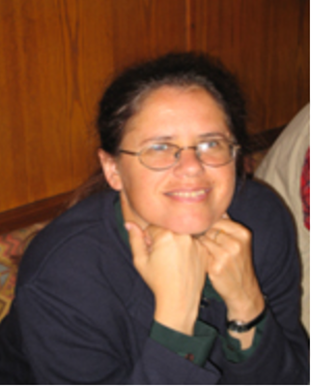【百家大讲堂】第198期:ZrO2基材料体系的实验研究和热力学模拟
来源: 发布日期:2019-05-15
【百家大讲堂】第198期:ZrO2基材料体系的实验研究和热力学模拟
讲座题目:ZrO2基材料体系的实验研究和热力学模拟
报 告 人:Fabrichnaya Olga
时 间:2019年5月24日 上午8:30 -10 : 30
地 点:5号教学楼502-1
主办单位:研究生院、材料学院
报名方式:登录华体会hth·(体育)(中国)官方网站-华体会体育hth首页微信企业号---第二课堂---课程报名中选择“【百家大讲堂】第198期:ZrO2基材料体系的实验研究和热力学模拟“
【主讲人简介】

Fabrichnaya Olga,现任德国弗莱贝格大学教授,她的主要领域涵盖陶瓷系统的热力学模型、相平衡的实验研究、热分析和量热法等。截止至今,Olga教授已发表约150篇研究论文,出版书籍一部,题为《Thermodynamic data, model and phase diagrams in multicomponent oxide systems》。
Fabrichnaya Olga was born in 1960 in Moscow (Russian federation), graduated from Chemistry department of Moscow State University in 1983. In 1983 she was accepted as Ph. D. candidate in Institute of Geochemistry and Analytical Chemistry of USSR Academy of Sciences. She got Ph.D. in chemistry in 1988. In 1992 she went to work in cooperation project in Uppsala University, Sweden. In 1998 she got Ph. D. in mineralogy, petrology and geochemistry. In 1998-1999 she worked in Royal Institute of Technology, Stockholm, Sweden. From 1999 to 2006 she worked in Max-Plank-Institute in Stuttgart, Germany and Stuttgart University. From 2006 up to present time Olga Fabrichnaya is employed in Technical University of Freiberg, Germany. Her main research interests are thermodynamic modelling of ceramic systems, experimental investigation of phase equilibria, thermal analysis and calorimetry. She is a co-author of ~150 research papers and one book Fabrichnaya O., Saxena S.K., Richet P., Westrum E.F. (2004): “Thermodynamic data, model and phase diagrams in multicomponent oxide systems”, Springer Verlag, Berlin Heidelberg.
【讲座信息】
本次讲座将介绍ZrO2基材料体系的相平衡研究及热力学模拟的实验结果。由于这些材料的广泛应用,其相关系的研究极为迫切。由MgO稳定氧化锆(Mg-PSZ)增强的高合金奥氏体不锈钢TRIP-钢(相变诱导塑性)在压缩中表现出非常高的比能吸收值,是TRIP-基质-复合材料的基础。Mg-PSZ在变形过程中显示出四方相到单斜相的马氏体相变,导致额外的强度增加。由于氧化锆颗粒和TRIP钢之间的粘合增加,可添加少量TiO2改善复合材料的机械性能。目前,关于ZrO2-TiO2-MgO体系中相关系的信息很少,亟待研究。这项工作的目的是对ZrO2-TiO2-MgO体系的相关系和热力学数据库开发的实验研究。稀土(RE)锆酸盐由于其极低的导热性而作为TBC材料受到越来越多的关注。近年来发现,通过阳离子取代可以实现热性能和机械性能的更多改进。然而,关于相平衡的文献数据主要用于二元RE2O3-ZrO2系统,RE2O3-RE'2O3-ZrO2系统的热力学数据非常少。这项工作的目的是对ZrO2-La2O3-Gd2O3和ZrO2-La2O3-Yb2O3系统的相关系和热力学数据库开发的实验研究。使用共沉淀法通过滴加Zr(CH3COO)水溶液的混合物制备样品,Ti2(SO4)3和Mg(NO3)2到NH4OH水溶液中,然后蒸发和热解。对于含稀土体系Zr(CH3COO)4,La(NO3)3·6H2O,Gd(NO3)3·6H2O和Yb(NO3)3·6H2O的样品制备溶于水,按所需比例混合并用作前体在NH4OH水溶液中共沉淀的溶液。将获得的沉淀物过滤并进行热解。对于所有考虑的系统,进一步的程序是相同的。通过X射线粉末衍射鉴定长时间热处理后稳定的相组合。通过差热分析(DTA)测定不变反应的温度。使用扫描电子显微镜结合分散X射线光谱法研究样品微结构。基于所获得的实验数据,建立了在1550,1700和1900K温度下ZrO2-TiO2-MgO体系的等温截面。对于具有萤石结构的相,发现了均匀性范围的宽三元延伸。在βZrTiO4和四方ZrO2相中发现MgO的溶解度非常有限,而在TiO2-MgO体系的中间体化合物中发现了更大的ZrO2溶解度。在1550K下显示出类似于δ-相Y4Zr3O12的低温三元化合物。差热分析显示该相的稳定性高达1631K。测定了两个共晶反应的温度和组成。基于获得的实验结果,使用CALPHAD方法优化ZrO2-TiO2-MgO体系的热力学参数。在ZrO2-La2O3-Gd2O3和ZrO2-La2O3-Yb2O3体系中,发现了三元体系中萤石相的广泛延伸。 Pyrochlore阶段RE2Zr2O7形成连续固溶体(La,Gd)2Zr2O7并且显示出有限的Yb2O3溶解度(~20mol。%)。 ZrO2-La2O3-RE2O3系统中的固态转变表明在1673-1873 K范围内:(La,Gd)2O3_A +萤石=(La,Gd)2O3_B + Pyrochlore为RE = Gd和萤石+ LaYbO3 = Pyrochlore +(Yb)对于RE = Yb,La,Zr)2O 3 + x_C。使用DTA测定这些转化的温度。基于所获得的结果,评估所研究系统的热力学参数并计算相图。"
The experimental results for phase equilibrium study and thermodynamic modelling of the ZrO2-based system will be presented. Phase relations in the ZrO2-based systems are important because of various applications of these materials. High-alloyed austenitic stainless TRIP-steel (Transformation Induced Plasticity) reinforced by MgO stabilized zirconia (Mg-PSZ) exhibits extraordinary high values of specific energy absorption in compression and is the base of TRIP-Matrix-Composite material. The Mg-PSZ shows a martensitic transformation of tetragonal to monoclinic phase during deformation resulting in additional strength increase. Minor addition of TiO2 improves mechanical properties of the composite due to increase of bonding between the zirconia particles and the TRIP steel. Materials based on the ZrO2–TiO2–MgO system are also of interest due to their dialectical properties. Information on phase relations in the ZrO2–TiO2–MgO system was scarce and new experimental study was necessary. The aims of this work are experimental study of phase relations and thermodynamic database development for the ZrO2–TiO2– MgO system. Rare earth (RE) zirconates attract more and more attention as TBC materials due to their extremely low thermal conductivity. In recent years it was found that even more improvement in both thermal and mechanical properties can be achieved via cation substitution. However, literature data on phase equilibria are available mostly for binary RE2O3–ZrO2 systems, with very little thermodynamic data for the RE2O3–RE’2O3–ZrO2 systems. The aims of this work are experimental study of phase relations and thermodynamic database development for the ZrO2– La2O3–Gd2O3 and ZrO2–La2O3–Yb2O3 systems Samples were prepared using the co–precipitation method by dropping the mixture of aqueous solutions of Zr(CH3COO)4, Ti2(SO4)3 and Mg(NO3)2 to the aqueous solution of NH4OH followed by evaporation and pyrolysis. For sample preparation in rare earth containing systems Zr(CH3COO)4, La(NO3)3·6H2O, Gd(NO3)3·6H2O and Yb(NO3)3·6H2O were dissolved in water, mixed in desired ratio and used as precursors solutions for coprecipitation in NH4OH aqueous solution. Obtained precipitates were filtrated and subjected to pyrolysis. The further procedure was the same for all considered systems. Phase assemblages stable after long heat treatment were identified by X-ray powder diffraction. Temperatures of invariant reactions were determined by differential thermal analysis (DTA). Sample microstructures were investigated using scanning electron microscopy combined with dispersive X-ray spectrometry. Based on the obtained experimental data, isothermal sections of the ZrO2–TiO2–MgO system at temperatures 1550, 1700 and 1900 K were established. Wide ternary extension of homogeneity range was found for phase with fluorite structure. Very limited solubility of MgO was found in beta ZrTiO4 and tetragonal ZrO2 phase, while more substantial solubility of ZrO2 was found in the intermediate compounds of the TiO2-MgO system. Low temperature ternary compound similar to δ-phase Y4Zr3O12 was revealed at 1550 K. Differential thermal analysis had shown stability of this phase up to 1631 K. Temperatures and compositions of two eutectic reactions were determined. Thermodynamic parameters of the ZrO2–TiO2–MgO system were optimized using CALPHAD approach based on the obtained experimental results. In the ZrO2-La2O3-Gd2O3 and ZrO2-La2O3-Yb2O3 systems wide extension of fluorite phase in ternary system was found. Pyrochlore phase RE2Zr2O7 forms continuous solid solutions (La,Gd)2Zr2O7 and demonstrates limited solubility of Yb2O3 (~20 mol.%). Solid state transformations were indicated in the ZrO2-La2O3-RE2O3 systems in the range 1673-1873 K: (La,Gd)2O3_A+Fluorite=(La,Gd)2O3_B +Pyrochlore for RE=Gd and Fluorite+LaYbO3=Pyrochlore+(Yb,La,Zr)2O3+x_C for RE=Yb. Temperatures of these transformations were determined using DTA. Based on the obtained results thermodynamic parameters of the investigated systems were assessed and phase diagrams were calculated.
